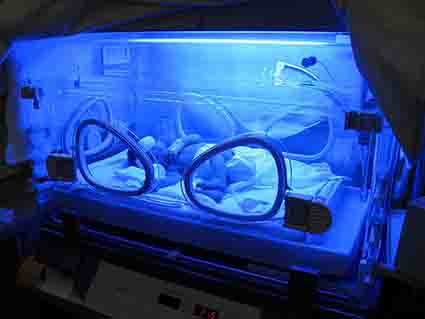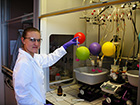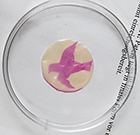Une membrane photosensible renfermant un dépôt de substances actives
Un petit coup de fouet à la caféine pour les bébés prématurés

| photo: iStockphoto | |||
| En médecine, on assiste de plus en plus au développement de techniques mini-invasives et non-invasives. Il est ainsi aujourd’hui possible d’effectuer de nombreuses opérations pour ainsi dire à travers un trou de serrure, sans grandes incisions au scalpel ni cicatrices importantes. Il existe maintenant aussi des possibilités similaires pour l’administration des médicaments: au lieu du recours à une seringue ou à une sonde gastrique, les substances actives pourront à l’avenir être intégrées dans un patch qui les délivrera ensuite de manière lente et continue à travers la peau. | |||
| Un patch imprégné de médicaments contre la phobie des piqûres Depuis quelques années, on administre aux bébés nés avant terme de la caféine afin de prévenir les arrêts respiratoires intermittents, appelés apnée du prématuré. Cette caféine leur est administrée. | |||
| | |||
| La membrane est activée par du spiropyrane ce qui la rend «commutable». | ||
| | |||
| Dans un projet financé par le Fonds national suisse et mené en commun avec l’hôpital universitaire de Zurich, l’Empa a développé un patch qui délivre la substance active à travers une membrane. Ce patch est simplement collé sur la peau du prématuré et délivre par exemple de la caféine continuellement durant quelques heures à ce petit patient sans qu’il ne doive être dérangé de manière importante par une piqûre. | |||
| Développé en laboratoire – testé dans un hôpital universitaire La membrane développée par l’Empa modifie ses propriétés lorsqu’elle est exposée à un rayonnement ultraviolet. Un effet que l’on trouve par exemple sur les verres de lunettes de soleil dits photochromiques sur lesquels de l’argent réagit avec le rayonnement UV et provoque ainsi l’obscurcissement des verres. Sur cette membrane ce sont toutefois d’autres groupes fonctionnels photosensibles, appelés spiropyranes, qui augmentent la perméabilité de la membrane de manière à ce que les substances actives passent plus vite à travers elle. Cette fonction demeure alors assurée durant plusieurs heures. En absence de rayonnement ultraviolet la membrane retient les substances actives dans son dépôt ainsi que l’ont rapporté récemment ces chercheurs dans une étude publiée dans la revue scientifique «Advanced Functional Materials». | |||
| | |||
| La membrane est illuminée à travers un masque: la silhouette d’un oiseau de couleur rose apparaît là où la lumière UV a activé la membrane. | ||
| | |||
| Un critère important dans le développement de cette membrane était la possibilité d’un contrôle précis de la quantité et de la durée de l’administration de la substance active. Les médecins de l’hôpital universitaire de Zurich qui ont participé à son développement considèrent que ce nouveau patch a de bonnes chances de succès sur le marché car son taux de relâchement peut se contrôler avec précision et s’adapter de manière individuelle aux patients. Cependant il pourrait encore s’écouler quelque temps avant que ces derniers puissent profiter de ce nouveau développement. L’Empa est actuellement à la recherche d’un partenaire pour la production industrielle de ce patch. | |||
| | |||
| La lumière visible n’active pas les groupes fonctionnels inclus dans la membrane (à gauche), alors que la lumière UV les active (à droite). Ceci permet un relâchement de la substance active contenue par le patch après activation par de la lumière UV. | ||
| | |||
| Bibliographie | |||
| Les illustrations peuvent être téléchargées ici. | |||
| |||
| |||



